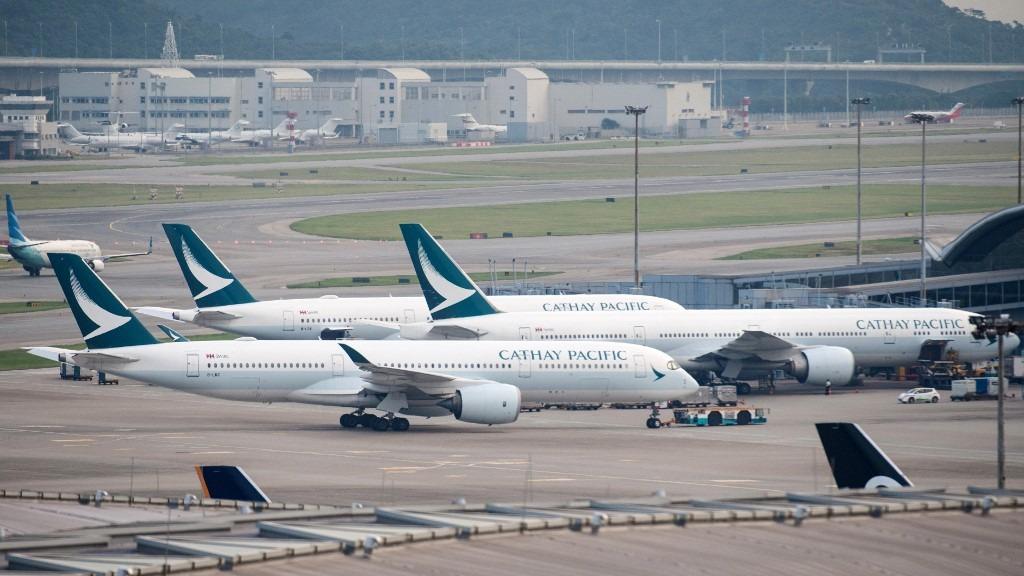 Cathay Pacific Airways passenger jets are seen on the tarmac at Hong Kong International Airport. (ANTHONY WALLACE / AFP)
Cathay Pacific Airways passenger jets are seen on the tarmac at Hong Kong International Airport. (ANTHONY WALLACE / AFP)
Hong Kong’s flagship airline Cathay Pacific Airways forecast a “substantial loss” for the first half of 2020, as the novel coronavirus prompts travel restrictionsand puts further pressure on the carrier already battered by months of social unrest.
The airline expected the first half of 2020 will be “extremely challenging financially”, with the coronavirus outbreak adversely impacting its financial performance and liquidity position, it said in a statement on Wednesday when releasing its annual results.
As travel demand has plunged, Cathay saw a “severe” drop in forward bookings.
We were faced with an incredibly challenging environment to operate in, as the Hong Kong economy slipped into recession. Our second-half results — traditionally stronger compared to first-half results — fell well below what we would have hoped for
Patrick Healy, chairman of Cathay Pacific Airways
“The average booking per day has dropped to around 15,000 to 16,000, compared to our normal passenger boardings of around 90,000 per day," Chief Customer and Commercial Officer Ronald Lam Sui-portold the media.
He added that on some days, bookings could drop to as low as 11,000.
Passenger load factor declined to around 50 percent at the end of February, and the yield, the money it makes on air tickets, had fallen significantly, according to Cathay.
Cathay Chairman Patrick Healy said the airline has adopted a number of short-term measures to help deal with this situation — "including a sharp reduction of capacity in our passenger network".
Cathay has cut passenger capacity by 30 percent for February and 65 percent for March and April. Flight frequencies were also cut by 65 percent and 75 percent, respectively, over the same period.
The airline slashed passenger capacity to cope with the reduced travel demand. This could help save costs and cash, explained Augustus Tang, chief executive officer at Cathay, adding they will increase capacity when the situation gets better.
However, for the time being, cuts in passenger capacity and flight frequencies are likely to continue in May, said Healy. He noted it is difficult to predict when these conditions will improve.
The airline has asked all staff to take three weeks' unpaid leave on a voluntary basis between March and June to cut costs. About 80 percent of employees have agreed to this; and Cathay has not ruled out job cuts, added Healy.
He stressed they are also working with business partners to demand more relief measures.
Hong Kong Airport Authority introduced a round of such measures last month, including rental concessions and a reduction or waiver of fees.
Healy said these measures were not sufficient, and did not “reflect the scale of challenge” the aviation industry was facing.
Cathay reported a net profit of 1.69 billion for the full year of 2019, a fall of 28 percent year-on-year, better than expectations. But profit in the second half of year only recorded HK$344 million with social unrest in Hong Kong intensifying and also mounting Sino-US trade tensions.
“We were faced with an incredibly challenging environment to operate in, as the Hong Kong economy slipped into recession. Our second-half results — traditionally stronger compared to first-half results — fell well below what we would have hoped for,” Healy said in the statement.
He noted that inbound traffic was hit very hard by incidents in Hong Kong in the second half of the year — particularly on short-haul and Chinese mainland routes.
Overall revenue including passenger services and cargo services dropped 3.7 percent to HK$106.97 billion. Revenue passenger kilometers to and from the mainland were down 10.9 percent.
Hong Kong Express, the low-cost carrier purchased by Cathay last year, reported a loss for 2019, against expectations of a small profit. It posted a loss of HK$246 million for the period from July 20 to December 31 last year after the acquisition.



